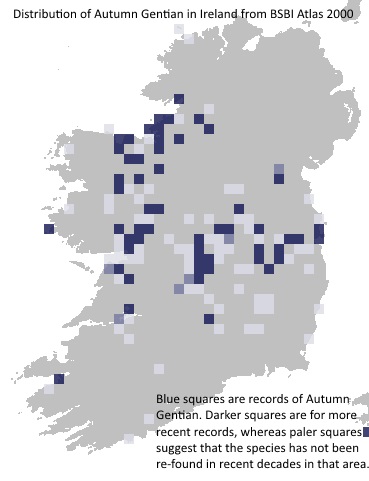Status
Native status
Native
Species Biology
Identification
- Plants grow to about 30 cm, and flower between July and October.
- They are biennial, taking two years for seeds to grow to mature plants which then die after flowering.
- The plants have a basal rosette of sometimes purplish spathulate (spoon-shaped) leaves from which branching flowering stems grow.
- The basal leaves have often died when the plant is flowering. The flowering stems have 5 to 10 pairs of small pointed leaves, 1-2cm long.
- Several purple flowers are borne at once on the top of each plant. The flowers have a tubular corolla (joined petals), which ends in five pointed and spreading tips.
- Inside the corolla there is a fringe of white hairs, at the junction between the tube and the star-like lobes.
- The corolla is surrounded by a short calyx (the sepals) which also has 5 pointed lobes.
Similar/related species:
The closely related species, Field Gentian
(Gentianella campestris), which also grows
in Ireland and flowers at the same time, may be confused with Autumn Gentian. Here
are a few tips to help tell them apart:
·
Field Gentian is generally
shorter than Autumn Gentian.
·
The flower parts (calyx and
corolla) are usually 4 lobed in Field Gentian, unlike Autumn Gentian which generally
has five lobed floral parts.
·
Field Gentian is more likely to
be found in neutral or acidic grassland, whereas Autumn Gentian prefers
calcareous soils.
·
The calyx lobes (i.e. the
sepals) are unequal in size in Field Gentian (with two being very broad and
overlapping the other two), whereas the calyx lobes are more or less all of
equal size in the Autumn Gentian.
Habitat
Autumn Gentian grows in dry or gravelly
grassland habitats on basic soils.
Threats faced
Autumn Gentian habitats are under threat of being lost due to land abandonment, changes of use, and agricultural improvement.
Distribution
World distribution(GBIF)
BSBI distribution map

Temporal change
Records submitted to Data Centre in 2024
The following map is interactive. If you would prefer to view it full screen then click here.
How can you help
If you have seen Autumn Gentian or any of
the species in the Irish Species Project, please download the guidance document
for detailed instructions and the recording form where
you can tell us about the plants you’ve seen (also available at http://www.bsbi.org.uk/ireland.html).
You can also get in touch with your local
BSBI Vice County Recorder via Maria Long, BSBI Irish Officer (maria.long@bsbi.org) or contact her if you have any questions.
Further information
One of eight species chosen for the Irish Species Project, a two year recording effort by the Irish division of the Botanical Society of Britain and Ireland (BSBI). All eight species are thought to be declining, at least in parts of their range.
Full list of eight species included in the Irish Species Project:
Moonwort (Botrychium lunaria), Cyperus Sedge (Carex pseudocyperus), Autumn Gentian (Gentianella amarella), Toothwort (Lathraea squamaria), Grass-of-Parnassus (Parnassia palustris), Cowslip (Primula veris), Common Wintergreen (Pyrola minor), Cranberry (Vaccinium oxycoccos)
References
Publications
Parnell J. and Curtis T. (2012) Webb’s An Irish Flora. Cork: Cork
University Press 8th ed.
Poland J. and Clement E. (2009) The vegetative key to the British flora. Southampton:
John Poland in association with The Botanical Society of Britain and Ireland
Preston C.D., Pearman D.A. and Dines T.D.
(2002) New Atlas of the British and Irish
Flora: An Atlas of the Vascular Plants of Britain, Ireland, the Isle of Man and
the Channel Islands. Oxford: Oxford University Press
Rose F. and O’Reilly C. (2006) The Wild Flower Key: how to identify wild
flowers, trees and shrubs in Britain and Ireland. London: Frederick Warne rev.
ed.
Stace C. (2010) New Flora of the British Isles. Cambridge; New York: Cambridge
University Press 2010 3rd ed.
